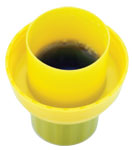
By limiting its cap size to hold one ounce--the amount for a medium-sized load--Method inhibits consumers' inclination to use too much detergent.
Overdosing can be a real problem for many Americans.Fortunately, it’s not that type of OD’ing. Rather, we’re talking about people using too much laundry detergent, an issue perhaps caused by user mistakes or by poor design of the caps on some containers and bottles-or maybe a combination of the two.
During testing for Consumer Reports’ latest report on laundry detergents, technicians and other staffers noted how hard it was to decipher the fill lines on several caps.
“If the lines aren’t clear or are hard to see, it’s easy to overdose and use too much detergent,” says Pat Slaven, a program leader in Consumer Reports’ technical department who conducted the detergent testing. “Plus, for all the products we tested, the line for a medium load-the most commonly done load-is less than a full cap, which makes it easier to use too much detergent.”
The line identifying the amount of detergent required for a maximum load is also typically less than a full cap.
Since some of the tested detergents cost as much as 65 cents per load, using too much cleaner could become expensive for consumers. Overdosing can also cause soap deposits and lint to form inside washing machines, which, say some manufacturers, might contribute to mold and odors.
It could also plug or restrict ports or filters, says Chris Zeisler, an appliance-repair expert at RepairClinic.com, who adds that those deposits could result in mechanical failure. And, for some high-efficiency washers, overdosing can produce excessive suds and lead to extended wash cycles as the machine tries to remove the soap.
“I’ve been in a lot of focus groups with consumers who say they’ve ruined high-efficiency machines because they used too much detergent,” says Michele Hall, marketing director at Method Products. “With the growth in high-efficiency washing machines that are so sensitive to overdosing, it’s important that people learn how to dose properly.”
Even a textiles expert can face issues with detergent caps.
“The salesman who sold us our energy-efficient washer emphasized that we should follow directions to the letter-or fill line, in this case. Of course, I have to stand under a floodlight in the garage to see the fill line,” says Margaret Rucker, Ph.D., a professor of textiles and clothing at the University of California at Davis. “If a study on cap design hasn’t been done, then it should be,” she adds.
Of course, some manufacturers have tried to address overdosing.
“The way we thought about cap design was to expose the dirty little secrets of the [laundry-detergent] category, and one of them is overdosing,” says Hall. “It’s consumers’ natural behavior to overdose. People want to add in a little more for cleaner clothes, or they’re used to dosing at a certain level, or the lines are pretty hard to read so that consumers either don’t look for them or aren’t able to read them.”
Method’s approach for detergents like its Squeaky Green 3X Concentrated HE is to limit the size of the cap to about one ounce, the right amount for a medium-size load in an HE washer. “It’s actually a little over an ounce to avoid runoff,” Hall says. “If we had chosen a larger cap, we would need to be really explicit.”
That cap also has a rim to catch spills.
It’s a good solution, though Consumer Reports noted Method’s instructions, which indicate that heavily soiled loads require one-and-a-half capfuls, and reported that the half-cap line was a bit tricky to discern from another similar mark a bit lower on the cap.

Consumer Reports found the dosage lines on All detergent's cap hard to read, but considered the outside rim (to catch overfill) a good feature.
Littlefield admits, “It’s a struggle to find proper dosage.”
Consumer Reports agrees, reporting that the markings on the All Small & Mighty 3X Concentrated Stainlifter’s yellow cap were hard to read, but, at the same time, applauding the rim around the outside of the cap that could catch overfill.
Like Sun Products Corporation, Procter & Gamble also shows images of the actual caps and fill lines on its Tide, Cheer and Gain labels (Consumer Reports indicated that the clear cap from Tide 2X Ultra with Color Clean Bleach Alternative had well-marked and numbered lines). “We have specific fill caps that are clearly marked, and we feel people understand the product,” says Lauren Thaman, a chemist and head of U.S. external relations at P&G.
But many consumers don’t read the label on their detergents. A 2003 survey from the Soap and Detergent Association showed that 49 percent of Americans never read the directions on a laundry-detergent package. As such, says SDA spokesman Brian Sansoni, “More attention is being paid to the labels and grocery-store aisle displays; some manufacturers are adding external tags that clearly state the amount that should be used.”
Some consumers are taking matters in their own hands. To be sure he used the right amount, one blogger took to “hacking” his laundry packaging (see http://tinyurl.com/37zv5f for his post), making hash marks on the outside of the caps-which, to us, is an insight that laundry brand marketers need to consider as a point of reference for making their packaging more convenient to use.BP
This article is adapted from a Consumer Reports Home and Garden blog posting by Gian Trotta. For more information, visit www.consumerreports.org.
